More from Albert Breer: Cowboys’ Chris Vaughn Explains Viral Moment When Team Drafted His Son | How, and When, the Panthers Finalized Their Draft Decision
Busy weekend, a lot to get to, so let’s dive into the takeaways …
The Cardinals have had a rough offseason—going right up to last week, with the tampering settlement on their contact with coach Jonathan Gannon in February. But they may have been draft weekend’s biggest winner. I believe the two guys who’d have been under consideration for Arizona with the No. 3 pick were Ohio State tackle Paris Johnson Jr. and Alabama edge rusher Will Anderson Jr.
They wound up with Johnson (who I think they preferred), and a lot more, with new GM Monti Ossenfort dropping back nine picks, then going back up six. Here’s how it all shook out …
• The Cardinals gave up the third, the 34th, 105th and 168th picks.
• They got Johnson, plus the 33rd and 81st picks this year, and first- and third-round picks in 2024.
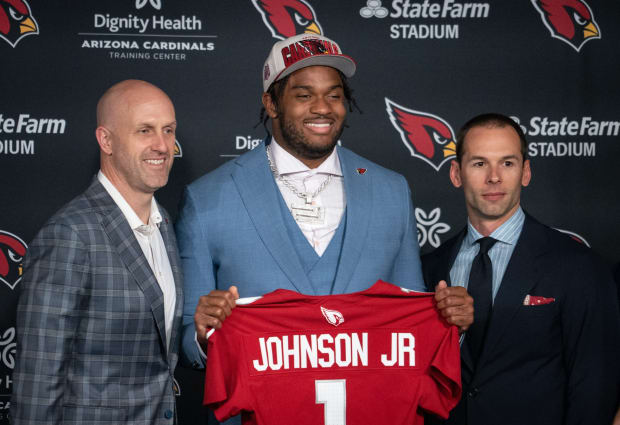
Mark Henle/The Republic/USA TODAY NETWORK
Or, if you want to simplify this, they got Johnson, moved their second-round pick up a spot (34 to 33), and sent fourth- and fifth-round picks away for a third-rounder this year, and first- and third-rounders next year. Which shows, to me, impressive command for the draft class by a rookie GM.
So how’d Ossenfort do it? Well, it starts with identifying Johnson. Arizona felt like the Buckeyes star crushed the predraft process, including a 30 visit the big man made to Tempe to see his future team. On that visit, he told Ossenfort and Gannon that his family’s history with the franchise—his dad, a defensive back out of Miami of Ohio, was drafted by the team in 1999—gave him business to finish in Arizona.
“I want to be here,” he told them.
Now, it’d be easy for any kid to say that to any team, but it came off as genuine to Ossenfort and Gannon. And it’d be meaningful, too, with the new bosses in Arizona looking for guys who had clean profiles who could grow into the “program guy” types that would make the Valley a good place for players to go.
DeAndre Hopkins Hints He Wants to Stay With Cardinals
As for the maneuvering itself, it really started with calls during the week to engage teams on coming up for the pick, with those bleeding into the hours before the draft, and the relationship Ossenfort had with Texans GM Nick Caserio (the two worked together for 14 seasons in New England). After Caserio took Ohio State QB C.J. Stroud (more on that later) at No. 2, at least one team interested in the third pick dropped off. But Ossenfort knew the Texans, because of his relationship with Caserio, would stay in.
The Cardinals took negotiations all the way until there were two minutes left on the clock, with other teams seeing the price as too high—a price that Ossenfort set with the desire to either get a pick in the range where the Cardinals would still get a player in their top cluster of prospects, or get enough back to get back into that range. The latter materialized with a monster package coming back from Houston (Nos. 12, 33, and the first and third picks in 2024).
From there, the Cardinals leaned on another relationship, between Lions GM Brad Holmes and their own assistant GM Dave Sears, who Ossenfort hired away from Detroit in February. The Colts weren’t moving, and it’d have been tough to do a deal in the division with Seattle, which left the Lions sitting there at six—and giving Arizona a chance to leapfrog another offensive line-hungry team in Vegas for Johnson. And that extra second-round pick they had—at 33—from Houston made it easy for the Cardinals to deal their slotted No. 2 at 34.
The Cardinals, by the way, then dealt 33 to the team Ossenfort came from, in Tennessee, to go down eight spots, moving up in the third round and getting another 2024 third-rounder as a result.
That leaves Arizona with Johnson, and six picks in the first two rounds of next year’s draft.
Not bad for Ossenfort’s first swing at this.
As for one of the Cardinals’ trade partners, the key to the Lions’ draft was adjusting on the fly. Sitting with the sixth pick didn’t work out for them. Detroit GM Brad Holmes figured if Arizona picked Johnson at No. 3, then one of the two completely clean defenders he saw in the class, Anderson or Illinois Devon Witherspoon, would slip to him. Then, the Cardinals traded out, the Texans took Anderson, and everything got thrown in a blender.
Holmes and Dan Campbell were facing a scenario where the Colts would take a quarterback and Witherspoon, who they’d targeted for months, would land in Seattle. And while the Lions figured the Seahawks might not pull the trigger—GM John Schneider had taken only one corner in the top 100 in 13 drafts in Seattle, and that one was the 90th pick (Shaquill Griffin in 2015)—Detroit still had to prepare for the possibility.
We didn’t think we’d do this at six, Holmes said to Campbell, but who cares? He’s our favorite guy left.
That guy was Alabama RB Jahmyr Gibbs.
My sense is Detroit felt the same way about him as they did Witherspoon—who they targeted months ago, and who they tried to hide their intentions on (they didn’t have Witherspoon in for a 30 visit, and Holmes and Campbell stayed away from his pro day). And who, ultimately, they hoped to pair with Witherspoon.
The initial idea was to get Witherspoon (or Anderson) at No. 6, then trade up from 18 to get Gibbs. Then Arizona traded out, the Colts took Anthony Richardson and, finally, to the Lions’ chagrin, the Seahawks took the draft’s top corner, a scenario under which, indeed, Detroit was ready to say who cares? and break the internet by taking Gibbs.
Thankfully, Ossenfort threw them a life raft.
The Cardinals gave Holmes the shot to pick up a high second, slide back six spots and, fingers crossed, still land Gibbs, by staying in front of two teams the Lions heard liked him, in the Patriots (at 14) and the Jets (at 15). So instead of Witherspoon and Gibbs, they wound up with Gibbs, and Iowa LB Jack Campbell (at 18) and TE Sam LaPorta (at 34).
In Gibbs, the Lions had another guy Holmes had long eyed. The GM live-scouted him at Alabama-Texas in September—when he arrived there to evaluate Bryce Young, Bijan Robinson and Anderson, he got a tip to “watch the transfer back from Georgia Tech”—and was impressed, when he was at field level, with how Gibbs was built and how he moved. In time, he’d come to look at Gibbs as more of a weapon than a back, and one who’d fit in his running back room as presently constituted better than Robinson would.
Also, on his 30 visit, Gibbs’s answer when the Lions asked what the best part of his game was—“my intelligence”—stuck with Holmes and Campbell.
As for Campbell, the team saw, rather than just an off-ball linebacker, a bit of a unicorn. He’s 6'5" and 249 pounds, loaded with instincts, plays downhill in the run game, is athletic enough to go sideline to sideline, and has the feel and the feet to cover ground in coverage, while being, in the words of one scout, “a tall tree to throw over.” Bottom line, they felt like he could be a 10-year centerpiece and one that was smart enough to where, per one team official, “he was damn near installing our defense” in their combine meeting with him.
And then, as a bonus for missing on Witherspoon, they get T.J. Hockenson’s replacement with another Hawkeye tight end.
All of which, to me, was a pretty nice recovery from a bumpy start for the rising Lions.
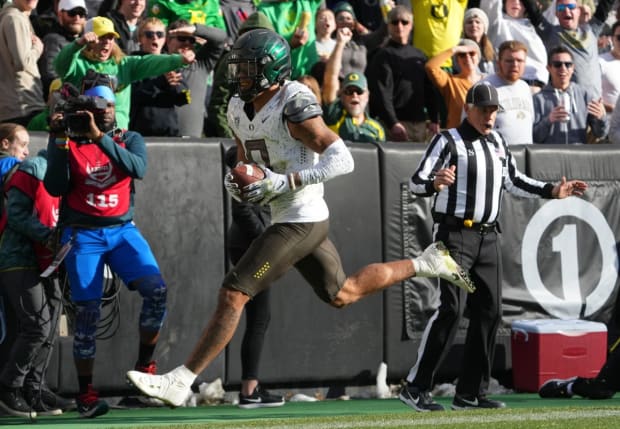
Ron Chenoy/USA TODAY Sports
The Patriots were another team that came away as a winner from the first couple of days of the draft—and I’ll say that with a caveat. We’ll get to that caveat in a second. We’ll start with what New England did with the 14th pick, and three positions of need (receiver, tackle, corner) as a focus coming into the draft.
Like the four teams in front of them, the Patriots did explore a move up, and also did work on moving back, before the draft. And the reason why is because they were in the sort of no-man’s-land area for this year, just below where the eight blue-chip nonquarterbacks (Anderson, Texas Tech's Tyree Wilson, Georgia's Jalen Carter as defensive front players; Johnson and Northwestern's Peter Skoronski at tackle; Witherspoon and Oregon's Christian Gonzalez at corner; and Robinson at running back) would come off the board.
Then, three quarterbacks went in front of them. The Bears preferred a longer, rangy tackle than Skoronski in Darnell Wright, Gibbs was picked, the Packers took a swing on high-upside Iowa DE Lukas Van Ness and Gonzalez was sitting there for New England.
I’d have taken him there, to be clear. But the Patriots had him in a cluster of four or so guys they valued at that part of the draft, and that allowed Bill Belichick to circle back on the Steelers’ overtures on coming up for a tackle, and ultimately take a fourth-round pick from them to move back three spots. And then, you had the Jets, who didn’t need a corner, and the Commanders, who preferred Emmanuel Forbes (who had some of the cleanest tape in the draft but weighs just 166 pounds) and, somehow, Gonzalez was still there at 17.
You know who else was in that cluster of players? Georgia Tech pass rusher Keion White, who they wound up drafting at 46. So they wound up with Gonzalez and Eastern Michigan G Sidy Sow for the 14th pick, and another guy they’d have been O.K. taking at 14.
Then, there’s the intelligence they got on those guys that helped with the decisions. New Patriots line coach Adrian Klemm was at Oregon last year, so he could give Belichick all the information he needed on Gonzalez (who had some reasonable, minor questions asked about his personality through the process), and Belichick built a relationship with former Tech coach Geoff Collins when the Patriots practiced at the school ahead of Super Bowl LIII, and has a scouting director on his staff in Pat Stewart, who worked with Collins more than a decade ago at Western Carolina, so they had all they needed on the freakish White.
Both will need some development, but both have high ceilings, and one fills a major need.
Which brings me to the caveat—the biggest need the Patriots had, to me, was tackle. It still hasn’t been addressed to the point it needs to be as I see it. And that’s a tough position to have a deficiency at. So they have to be crossing their fingers on Riley Reiff, Trent Brown and Calvin Anderson. Or that Klemm will be the second coming of Dante Scarnecchia, their former legendary line coach.
There’s as much pressure on Anderson as there is on Stroud in Houston. The reason why relates back to the Deshaun Watson trade. Bottom line, when a GM deals off a quarterback who accomplished what Watson did as a Texan (regardless of the circumstances), he will probably be defined by what he does with the return—and Nick Caserio will be defined by this draft.
Caserio got three first-round picks, a third-rounder this year and a pick swap next year.
Kenyon Green was the first of those first-round picks. You can see Anderson as, essentially, the last two (even if it was the Texans’ own 2024 first-rounder going to Arizona in the deal), if you assume Stroud would’ve been taken second regardless, and consider how losing the extra first-rounder next year robs Houston of valuable flexibility in what’s expected to be a very strong first round. Which means, yes, Caserio needs to be right on Anderson.
Will he be? It did seem like momentum slowed for the Alabama star in the weeks leading up to the draft, with the concern being that Anderson was like a lot of Crimson Tide prospects—maxed out by Nick Saban’s development machine, with the upside there nearly fully tapped. The flip side of that argument in the result for Anderson, and that the Texans went to No. 3 to get him, would be that between Caserio, a certified FON (Friend of Nick), and DeMeco Ryans, a Tide legend, probably have the very best intel on just how far Saban thinks Anderson can go.
Either way, again, this is one Caserio needs to get right.
And I say that with the acknowledgment, too, that it was smart to take Stroud first before Anderson as a way of short-circuiting the market the Cardinals had for the third pick, and making it easier for the Texans to pursue.
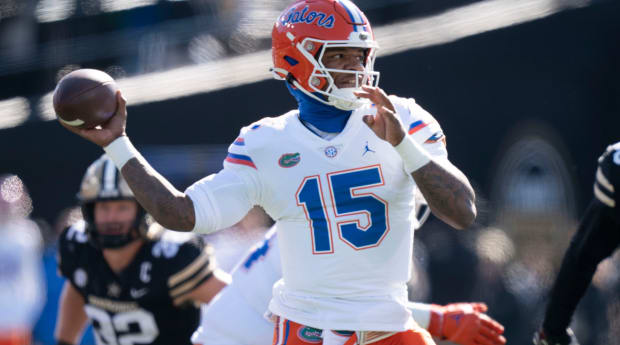
© George Walker IV / Tennessean.com / USA TODAY NETWORK
The consensus I’ve gathered on Richardson and Will Levis over the past few weeks fits the order in which the quarterbacks went—with those two after Young and Stroud. Accordingly, my sense is, if the Bears pulled off the double trade they’d planned, and if the Panthers were at No. 2, instead of No. 1 and Young was gone, they’d probably have taken Stroud, and that Titans were interested in going up to No. 3 for a QB, with that QB being Stroud.
“Of the four, just off the tape alone, it was Bryce and C.J. and then a good drop-off,” says one veteran AFC executive Friday. “You’re swinging for the fences with Will Levis and Anthony Richardson.”
That, of course, doesn’t mean everyone saw it that way.
I don’t know whether the Colts would’ve taken Stroud or Young over Richardson—but I do know the logic in taking the Florida star at No. 4 for the Indy brass was that those guys were willing to take the risk in projecting him to be something he may not be yet, over letting him go become a superstar somewhere else. And the logic isn’t unfounded for two reasons.
One, the pick fits into GM Chris Ballard’s traits-happy ethos. He’s always been strict on the physical elements needed for success at each position—in the old “if you make exceptions, you’ll wind up with a team full of them” tradition of Bill Parcells. When he was scouting for the Chiefs, Patrick Mahomes was a really good example of what betting on traits, and a kid’s ability to develop them, can do for a team. And while Mahomes had way, way more playing experience than Richardson, there are parallels in the freak flashes of both.
Two, coach Shane Steichen’s already got the blueprint for that sort of development, with what he just pulled off with Jalen Hurts as the Eagles’ offensive coordinator. Midway through his first year in Philly, Steichen got the play-calling reins, and more or less installed the Oklahoma run game to get Hurts rolling. It worked, and bought time for the rest of Hurts’s game to come along. It’s not hard to see a similar scenario where Steichen can put Richardson in position to produce right away, while getting more out of him behind the scenes.
So, yeah, the chances of a whiff on Richardson are greater than with Young and Stroud. But in a conference stocked with talented quarterbacks, this was worth the swing.
And as for Levis—on Friday, we covered a lot of how this happened with the Titans (he had his best predraft meeting with Mike Vrabel), and how Tennessee asked Levis to bring in cutups of his best and worst plays for his 30 visit. I’d add, too, that because he wasn’t a first-round pick (and he easily could’ve been, with the Titans having worked on a deal to go up to 27 with Buffalo late Thursday night), he might get a little more patience than he would in another circumstance. Which could really help.
The Titans aren’t married to him (they could easily take another QB next year or the year after), and thus can take their time with him. Not that Vrabel would rush a rookie quarterback out there, anyway.
Conventional wisdom holds that the Falcons’ pick at No. 8 was a relic of a time gone by, but I think it’s a possible look at where the game is going. And I know that sounds dramatic, maybe even a little ridiculous. So you’ll have to follow me here.
Atlanta coach Arthur Smith has long had a certain admiration for the way the San Antonio Spurs teams that made the NBA Finals in 2013 and ’14, and the Golden State Warriors teams that followed them were built. Yes, those teams had great Hall of Fame players. But what Smith loved about their construction was how they were versatile and positionless, which allowed them to pose problems for, well, everyone. And in some ways, the blueprint he and Terry Fontenot have drawn up in building the Falcons, has similar earmarks.
Robinson isn’t the genesis of that, but he’s a continuation of it.
Two years ago, the Falcons took Florida tight end Kyle Pitts in the top 10, a player who could be moved all over to generate matchups. Last year, it was USC’s Drake London, a player who has the size to be dominant outside, and the versatility and explosiveness to play inside or take the ball on end-arounds and sweeps. This year, it’s Robinson, a 220-pound jackhammer who can be their mail carrier, while being such a good receiver that the Falcons can legitimately line him up in the slot with game-breaking ability from both spots.
Simply put, each year, the Falcons felt like they were adding the draft’s best playmaker.
And now, the result, they hope, is a headache for defenses from the moment the offense breaks the huddle—with little to say who will line up where.
So in that way, the Falcons didn’t see Robinson as a tailback. They saw him as another queen on the chessboard for an offense that’s stockpiling them. Of course, there are still fair questions here. Whether they get enough from Desmond Ridder to unlock all of that is one. If they have enough up front on defense to make it work on the other side is another.
But the logic the Falcons used to get to the point where they were comfortable taking Robinson with the eighth pick isn’t that wild, and it certainly isn’t old school. It is, to be sure, unconventional from a group that prides itself on trying to disrupt and be a step ahead. And if it works, it sure could have an impact on how all of this works.
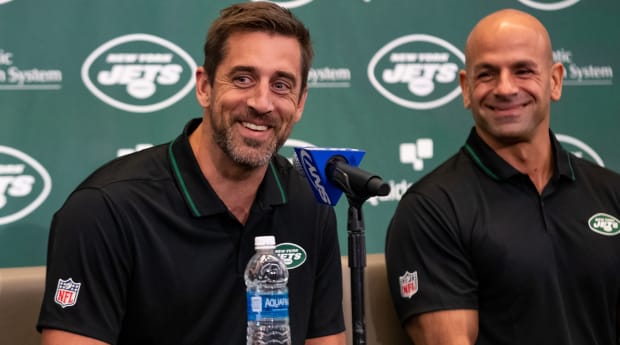
Tom Horak/USA TODAY Sports
It’s a really, really good sign that Aaron Rodgers is already taking part in the team’s offseason program. That, and Rodgers’s designs on playing two more years, were part of the Jets’ discussions with the quarterback before the trade. And that renewed investment, and fire, are important, in that we’ve seen what an older quarterback scorned (Tom Brady, Peyton Manning, Brett Favre) can do with that sort of motivational wind at his back.
Here’s what Robert Saleh has seen so far: “We’re a really, really young team, especially on offense, and just to watch him and Nathaniel [Hackett] and the way they communicate together, he’s already made his presence felt with regards to meetings and input, just discussions on all of the different things we’re trying to get accomplished on offense.
“He’s a tremendous human, first and foremost, Aaron is. Just listening to him, there are little, subtle things I’m not going to get into, but he definitely cares about people, and you can tell in the way he speaks to people. So we’re really fortunate that he’s here.”
Conversely, the past few years, Rodgers wasn’t part of the Packers’ offseason program, and there are people there who felt like last year—when the team was integrating rookies Christian Watson and Romeo Doubs to make up for the loss of Davante Adams—it really bit Green Bay. Watson and Doubs did come on late, and the sentiment was the breakthrough might’ve happened earlier had more work gotten done with the draft picks earlier.
Whether that was actually the case is debatable.
But that’s not the Jets’ problem and, evidently, won’t be going forward.
(We’ll have a lot more on Rodgers later in the week.)
If there’s one last takeaway on the Lamar Jackson contract, it’s to not hold your breath for the day of fully guaranteed contracts in the NFL. This will surprise some people, but in none of the four major sports in the country is there a CBA clause that either prohibits or mandates fully guaranteed contracts. Which is to say contracts are the way they are in football, baseball, basketball and hockey because individual negotiations got them there.
So if the NFL was ever going to have fully guaranteed contracts as a standard, it’d have to happen player by player, until all (or most of) the players had them.
It was five years ago now that Kirk Cousins got his groundbreaking, fully guaranteed, three-year, $84 million deal. A new day for players? Not exactly. Matt Ryan, Aaron Rodgers, Jared Goff and Carson Wentz all did blockbuster deals within 18 months of Cousins’s deal, and all reverted to the traditional quarterback contract structure, rendering the Vikings’ contract for their quarterback an outlier.
And similarly, in the 14 months since Deshaun Watson got his fully guaranteed, five-year, $230 million deal from Cleveland, Kyler Murray, Russell Wilson, Jalen Hurts and now Jackson have done top-of-the-market deals with a traditional quarterback structure that put the Watson deal in the same once-in-a-blue-moon category where Cousins’s landed.
The worst part for players is simply that if quarterbacks can’t consistently get over that hump, then it’s more or less going to be impossible for guys at other positions, too.
The Jackson negotiation certainly underscores why. After all, if you’re a player like the Ravens quarterback, hundreds of millions of dollars can be sitting there for only so long before you end up taking it. What’s more, it’d be tough to blame anyone for taking it. I know if I were Lamar, I would’ve done it long before he did—which is why there won’t be any change to all this anytime soon.
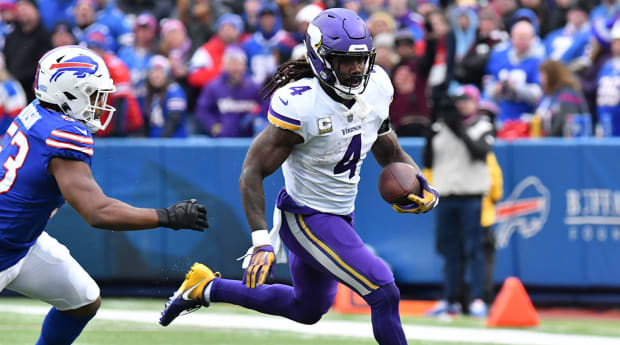
Mark Konezny/USA TODAY Sport
Trades will probably get more difficult to do now. The Broncos taking Marvin Mims Jr. in the second round Friday elicited a phone call or two to Denver from other teams wondering whether it was a signal things changed with either Jerry Jeudy, Courtland Sutton or both. Nothing had—Denver was still looking for a premium for both (a first-rounder for Jeudy, and a second-round pick for Sutton).
And now that the draft has passed, the price goes up on each guy, and other trade targets across the NFL.
The simplest way to explain why is that a pick next year is less valuable, because if you’re trading a player away for a pick next year, there’s a year in there where you’ll have neither player. And so since no one was willing to give up what it’d take to get the Broncos receivers in this year’s draft, and after a weekend through which teams were stingy with next year’s picks considering the expected strength of the coming class, it doesn’t add up that someone is gonna break the bank to get Denver to change its mind.
Another team this could affect would be the Vikings, with Minnesota more than willing to listen on Dalvin Cook and Za’Darius Smith. The former is due $11 million this year. No one is paying that, so the question becomes whether he takes less in Minnesota, or the Vikings pay to get a draft pick for him from someone else, or he hits the market. In Smith’s case, with $12.5 million due this year, the most likely scenario has the Vikings working a trade to buy a draft pick (in paying a chunk of Smith’s salary) or letting Smith go.
Obviously, it’ll require some needle-threading for either guy to be dealt.
Tuesday’s a relatively important day, with teams’ decisions on fifth-year options for 2020 first-round picks due. Eight options have been picked up so far—the ones for Bengals QB Joe Burrow, Dolphins QB Tua Tagovailoa, Chargers QB Justin Herbert, Bucs OT Tristan Wirfs, Falcons CB A.J. Terrell, Cowboys WR CeeDee Lamb, Vikings WR Justin Jefferson and 49ers WR Brandon Aiyuk.
And Giants OT Andrew Thomas’s option should be academic, with a bunch (Seahawks LB Jordyn Brooks, Ravens LB Patrick Queen) that’ll be interesting calls. Plus, the call on Jordan Love’s extension will probably be the most fascinating decision of them all.
We’ll know about Love, and the rest of them, in about 24 hours.
Bonus takeaway—thanks for following our coverage of the 2023 draft. I, and we, put a lot into it every year, so for a lot of us this weekend feels like a finish line. And don’t worry, with a verifiable bumper crop coming (USC QB Caleb Williams, UNC QB Drake Maye, Ohio State WR Marvin Harrison Jr., Georgia TE Brock Bowers, Penn State OT Olu Fashanu and Alabama edge rusher Dallas Turner head the class), it won’t be long until we turn the page to ’24.
(We’ll have more to wrap up the draft with in our Tuesday notes, so stay tuned for that.)







